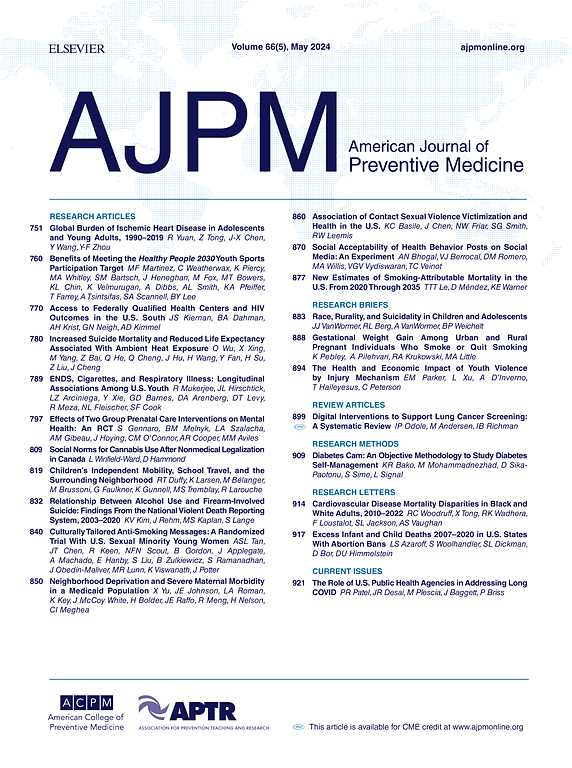物质使用障碍母亲参与儿童福利系统的风险。
IF 4.5
2区 医学
Q1 MEDICINE, GENERAL & INTERNAL
引用次数: 0
摘要
前言:本文旨在研究接受公共物质使用治疗服务的母亲参与儿童福利系统的相关因素。方法:这是一项队列研究,使用2015-2023年来自宾夕法尼亚州阿勒格尼县的相关数据,研究居民在公共服务系统中的互动。在研究纳入的三个月内测量的独立变量包括家庭特征、公共福利收据、监狱释放和物质使用障碍(SUD)诊断。结果,在随后的21个月,包括任何儿童福利互动,积极的情况下,和家庭外安置。这些数据是在2024-2025年进行分析的。结果:较年轻的母亲年龄,有多个孩子,有一个婴儿或年幼的孩子都与儿童福利系统参与的风险增加有关;有婴儿也与家庭外安置的风险相关(调整风险比(aHR) 2.54, 95%CI: 1.80-3.59)。虽然所有的SUD诊断都与所有类型的儿童福利系统参与的风险增加有关,但对于户外安置,兴奋剂(aHR 2.35, 95%CI: 1.64-3.36)和阿片类药物(aHR 2.18, 95%CI: 1.60-2.96)使用障碍的相关性最强。接受某些公共福利,如贫困家庭临时援助,也与儿童福利系统互动、活跃病例和家庭外安置的高风险相关(aHR 1.93, 95%CI: 1.41-2.65)。结论:特别需要加强对有阿片类药物或兴奋剂使用障碍的婴儿母亲的支持。接受某些公共福利强调了经济脆弱性是患有SUD的母亲参与儿童福利系统的关键途径。本文章由计算机程序翻译,如有差异,请以英文原文为准。
Risk of Child Welfare System Involvement Among Mothers With Substance Use Disorder
Introduction
This paper aimed to examine the factors associated with child welfare system involvement among mothers receiving public substance use treatment services.
Methods
This was a cohort study using 2015–2023 linked data from Allegheny County, Pennsylvania, on residents’ interactions across public service systems. Independent variables, measured within 3 months of study inclusion, included family characteristics, public benefit receipt, jail release, and substance use disorder diagnoses. The data, captured over the subsequent 21 months, included any child welfare interaction, active case, and out-of-home placement. The data were analyzed in 2024–2025.
Results
Younger maternal age, having multiple children, and having an infant or a young child were all associated with an increased risk of any child welfare system involvement; having an infant was also associated with a risk of out-of-home placement (adjusted hazard ratio=2.54, 95% CI=1.80, 3.59). Although all substance use disorder diagnoses were associated with an increased risk of all types of child welfare system involvement, for out-of-home placements, the strongest associations were observed for stimulant (adjusted hazard ratio=2.35, 95% CI=1.64, 3.36) and opioid (adjusted hazard ratio=2.18, 95% CI=1.60, 2.96) use disorders. Receipt of certain public benefits, such as Temporary Assistance for Needy Families, was also associated with higher risks of any child welfare system interaction, an active case, and out-of-home placements (adjusted hazard ratio=1.93, 95% CI=1.41, 2.65).
Conclusions
Enhanced support is particularly needed for mothers of infants and for those with opioid or stimulant use disorders. Receipt of certain public benefits underscores economic vulnerability as a key pathway to child welfare system involvement among mothers with substance use disorder.
求助全文
通过发布文献求助,成功后即可免费获取论文全文。
去求助
来源期刊

American Journal of Preventive Medicine
医学-公共卫生、环境卫生与职业卫生
CiteScore
8.60
自引率
1.80%
发文量
395
审稿时长
32 days
期刊介绍:
The American Journal of Preventive Medicine is the official journal of the American College of Preventive Medicine and the Association for Prevention Teaching and Research. It publishes articles in the areas of prevention research, teaching, practice and policy. Original research is published on interventions aimed at the prevention of chronic and acute disease and the promotion of individual and community health.
Of particular emphasis are papers that address the primary and secondary prevention of important clinical, behavioral and public health issues such as injury and violence, infectious disease, women''s health, smoking, sedentary behaviors and physical activity, nutrition, diabetes, obesity, and substance use disorders. Papers also address educational initiatives aimed at improving the ability of health professionals to provide effective clinical prevention and public health services. Papers on health services research pertinent to prevention and public health are also published. The journal also publishes official policy statements from the two co-sponsoring organizations, review articles, media reviews, and editorials. Finally, the journal periodically publishes supplements and special theme issues devoted to areas of current interest to the prevention community.
 求助内容:
求助内容: 应助结果提醒方式:
应助结果提醒方式:


